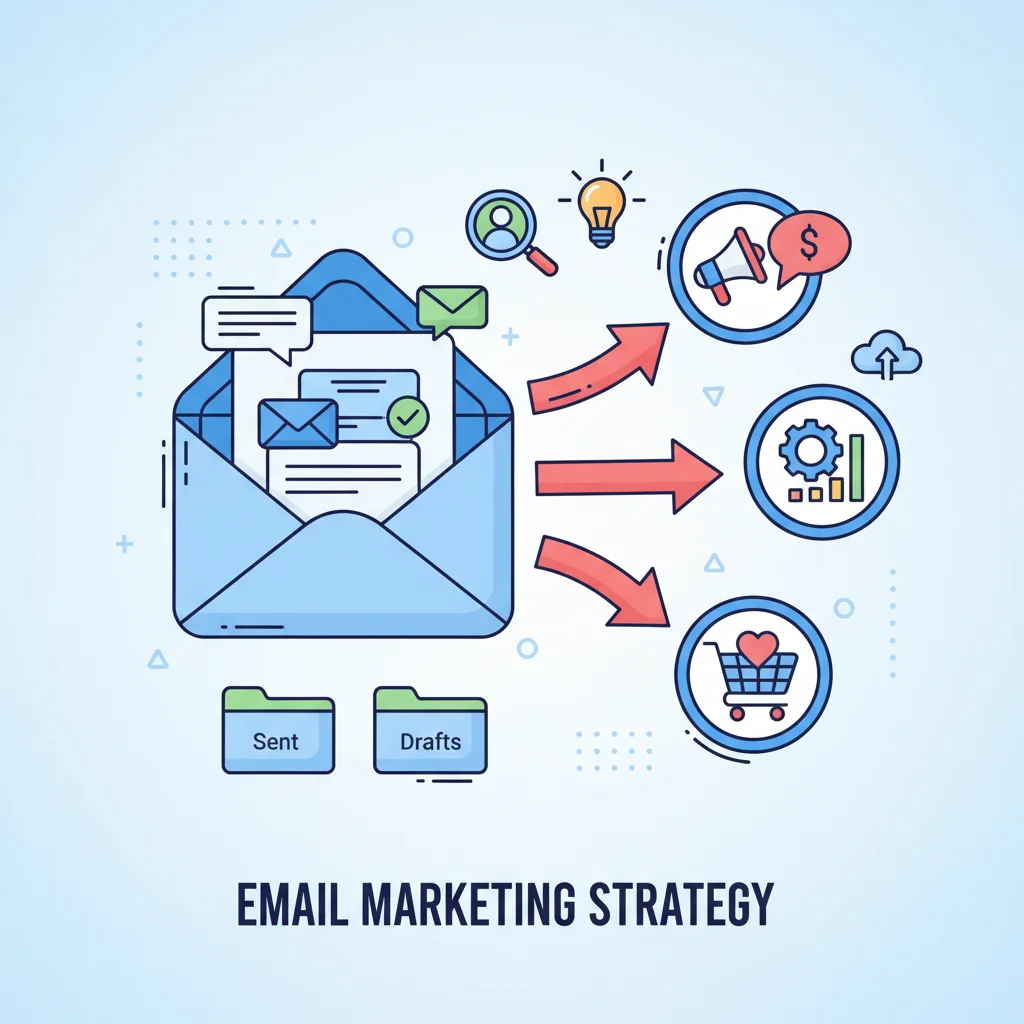Now Reading: Find Your Sweet Spot: The Ideal Length for Marketing Emails
-
01
Find Your Sweet Spot: The Ideal Length for Marketing Emails
Find Your Sweet Spot: The Ideal Length for Marketing Emails

There’s a magic number of words that could double your email marketing results overnight. It’s not 50. It’s not 500. The ideal length for marketing emails depends on factors most marketers completely overlook. What if I told you that 78% of high-performing email campaigns share a specific length pattern that you can easily replicate?
Key Takeaways
- The ideal length for marketing emails is typically between 50-125 words (approximately 20 lines of text)
- Emails under 200 words generally perform best with average click-through rates of 14.8%
- Different audiences and purposes require different lengths:
- Newsletters: 200-500 words
- Promotional emails: 50-150 words
- Transactional emails: 50-100 words
- Mobile optimization demands shorter emails (under 200 words) for better engagement
- Subject line length (30-50 characters) is just as important as email body length
- Quality always trumps quantity-relevance matters more than rigid word counts
The Science Behind Email Length
Let’s be real – nobody wakes up excited to read marketing emails. We’re all drowning in content, and your carefully crafted message is competing with approximately 100+ other emails hitting your reader’s inbox daily.
When it comes to the ideal length for marketing emails, the data is pretty clear: shorter is generally better. But “short” means different things depending on your audience, industry, and purpose.
Research from HubSpot shows emails with approximately 200 words result in response rates around 48%, while emails above 400 words see response rates drop below 30%. Yikes!
But here’s the thing-there’s no magical one-size-fits-all word count. I’ve seen super short 50-word emails bomb completely and occasional 500-word newsletters crush it with engagement.
The key is understanding the context.
Why Email Length Matters
Email length impacts:
- First impressions – Visual length creates immediate judgment
- Completion rates – Longer emails are less likely to be read fully
- Mobile experience – 60% of emails are opened on mobile devices where screen real estate is limited
- Cognitive load – Our brains prefer processing smaller chunks of information
- Perceived value – Length signals the time investment required from the reader
I’ve found that respecting your reader’s time is the ultimate form of email marketing respect. Every unnecessary word is another reason for them to hit delete.
Email Length By Purpose
Not all marketing emails serve the same purpose, so their ideal lengths differ significantly.
Promotional Emails (50-150 words)
When you’re promoting a product, service, or sale, brevity wins. These emails should:
- Get straight to the point
- Focus on a single, clear call-to-action
- Use bullet points for quick scanning
- Include minimal but compelling details
I once cut a promotional email from 300 words to 75 and saw click-throughs jump by 27%. The shorter version simply said what was on sale, why it mattered, and how to get it-nothing more.
Example structure for a promotional email:
- Attention-grabbing headline (5-7 words)
- Brief explanation of offer (25-30 words)
- Key benefit or urgency factor (15-20 words)
- Clear CTA button (3-5 words)
- Optional P.S. with secondary detail (10-15 words)
Newsletters (200-500 words)
Newsletters are the exception to the brevity rule. Subscribers expect more content here, but structure matters enormously:
- Use clear section headers
- Front-load the most important information
- Break content into scannable chunks
- Provide “read more” links for longer articles
My most successful newsletter follows a 300-word format with 3-4 sections, each with its own mini-headline and 60-80 words of content.
Transactional Emails (50-100 words)
Order confirmations, shipping updates, and account notifications should be ultra-concise:
- Confirm the essential information
- Provide next steps if needed
- Avoid marketing fluff
- Use simple, direct language
These emails have open rates of 80-85% because they contain information the reader actually requested. Don’t waste this attention with unnecessary words!
Useful Articles:
Email Length By Audience
Your audience’s preferences dramatically impact the ideal length for your marketing emails.
B2B vs B2C Audiences
B2B audiences often tolerate (and sometimes prefer) longer emails with more detailed information-especially for complex products or services. My B2B emails typically run 250-350 words and perform well.
B2C audiences generally prefer shorter, more emotionally-driven content under 200 words. When I write to consumers, I aim for 125-175 words maximum.
Industry Variations
Different industries have different email length expectations:
- Tech/SaaS: 200-300 words with technical specifics
- Retail/E-commerce: 100-150 words focusing on visuals and offers
- Financial services: 150-250 words balancing information with clarity
- Entertainment/Media: 75-150 words with strong visual elements
I’ve found that matching industry norms while being slightly more concise than competitors often works best.
Relationship Stage
The ideal email length also depends on where recipients are in their customer journey:
- New subscribers: 100-150 words to build initial engagement
- Engaged prospects: 150-250 words with more detailed information
- Loyal customers: Variable length based on relationship and purpose
When I’m nurturing new leads, I keep emails super short. As the relationship develops, I gradually increase length based on engagement data.
The Mobile Factor
With over 60% of emails now opened on mobile devices, screen size dramatically impacts the ideal length for marketing emails.
On mobile:
- A 200-word email looks like a novel
- Subject lines get cut off after 30-40 characters
- Images can overwhelm the screen
- Scrolling fatigue sets in quickly
I always test my emails on mobile first. If it feels too long on my phone, it IS too long-period.
Some mobile-specific length guidelines I follow:
- Viewable without scrolling: 50-75 words
- Single thumb-scroll: 100-150 words
- Multiple scrolls: Use very compelling subheadings every 50-75 words
Remember that on mobile, visual length matters as much as actual word count. An email with lots of white space and short paragraphs feels shorter than a densely packed email with the same word count.
Subject Line Length: The Gateway to Your Email
The ideal length for marketing emails starts with the subject line. This tiny piece of text determines whether your email gets opened at all.
Subject lines between 30-50 characters (about 6-8 words) typically perform best with open rates around 21%, compared to just 14% for longer subject lines.
Some subject line length principles I’ve found effective:
- Under 30 characters: Great for mobile but may lack detail
- 30-50 characters: The sweet spot for most audiences
- 50+ characters: Only effective for highly engaged audiences
I’ve tested hundreds of subject lines, and the pattern is clear: shorter, more specific subject lines consistently outperform longer ones.
Useful Articles:
Beyond Word Count: Quality Trumps Quantity
While I’ve been talking about ideal word counts, the truth is that relevance matters more than rigid adherence to length guidelines.
A perfectly targeted 300-word email will outperform an irrelevant 100-word email every time.
Focus on:
- Relevance: Does this content matter to this specific audience?
- Value density: Is every sentence earning its place?
- Clarity: Could I say this more simply?
- Purpose: Is my goal for this email crystal clear?
I regularly edit my emails using the “so what?” test. After each sentence, I ask “so what?”-if I can’t immediately explain why the reader should care, that sentence gets cut.
Email Structure: Making Length Work Harder
How you structure your email matters as much as its length. Good structure makes longer emails feel shorter and more accessible.
The Inverted Pyramid Approach
I structure most marketing emails using the inverted pyramid method:
- Most important information first (20% of word count)
- Supporting details in the middle (50% of word count)
- Call to action at the end (10% of word count)
- P.S. with secondary benefit or urgency factor (20% of word count)
This structure respects that many readers won’t make it to the end, so the crucial information is delivered immediately.
Formatting for Scannability
No matter your email length, formatting for scannability is essential:
- Paragraph length: Keep to 1-3 sentences maximum
- Bullet points: Use for lists and features
- Bold text: Highlight key points (but don’t overdo it)
- White space: Give content room to breathe
- Subheadings: Break longer emails into scannable chunks
I’ve found that proper formatting can make a 300-word email feel shorter than a poorly formatted 150-word email.
A/B Testing Email Length
Instead of blindly following general guidelines, I strongly recommend testing different lengths with your specific audience.
Some variables to test:
- Total word count: Try variations with 25% more or less content
- Paragraph length: Test single-sentence vs. multi-sentence paragraphs
- Section count: Compare emails with different numbers of topics
- CTA placement: Test early vs. late placement in different length emails
My most successful email campaigns came after testing 3-4 length variations and discovering what my specific audience preferred.
Useful Articles:
Industry-Specific Length Recommendations
Different industries have developed their own email length best practices based on audience expectations and content needs.
E-commerce
For e-commerce, product-focused emails perform best at 50-150 words. The emphasis should be on:
- Strong product visuals
- Clear pricing information
- Simple benefit statements
- Obvious call-to-action buttons
My e-commerce clients see the best results with emails that could be fully read in under 30 seconds.
SaaS and Technology
SaaS emails can run longer (200-300 words) because they often need to explain:
- Technical features
- Problem-solution scenarios
- Integration benefits
- Implementation steps
I structure these emails with very clear subheadings so readers can quickly find relevant sections.
Professional Services
Professional service emails (consulting, legal, financial) typically perform well at 150-250 words, balancing:
- Credibility signals
- Problem identification
- Solution overview
- Next steps or consultation offers
These emails need to convey expertise while remaining accessible-a delicate balance that requires careful editing.
Practical Length-Optimization Tips
After years of writing marketing emails, I’ve developed some practical techniques for finding the ideal length:
- Write long, edit short: Draft without length constraints, then cut 30-50%
- Read aloud test: If you run out of breath, your sentences are too long
- Mobile preview: If it requires more than 2-3 thumb scrolls, it’s too long
- 5-second skim: Can someone get the main point in a quick scan?
- Single-purpose rule: Each email should have ONE primary goal
I’ve saved countless emails from the delete bin by ruthlessly applying these principles.
The Psychology Behind Email Length
Understanding why length matters helps us make better decisions about our marketing emails.
Research shows that:
- The average adult attention span is about 8 seconds
- Reading speed averages 200-250 words per minute
- Decision fatigue increases with content length
- Cognitive load impacts comprehension and retention
This means a 200-word email takes the average person about 1 minute to read-if they’re fully engaged. But most readers are skimming, distracted, or reading on mobile devices.
I’ve found that respecting these psychological limitations leads to better performing emails.
When Longer Emails Work Better
Despite everything I’ve said about brevity, sometimes longer emails (300-500 words) perform better:
- Educational content: When teaching complex concepts
- Relationship building: For personal stories that create connection
- High-consideration purchases: When explaining significant investments
- Engaged audiences: For subscribers who consistently read your content
My newsletter emails run longer (400+ words) because subscribers have explicitly opted in for more detailed content. The open and click rates remain high because the length matches their expectations.
The Ideal Length for Marketing Emails: A Summary
After all this discussion, you might be wondering: what IS the ideal length for marketing emails?
Here’s my evidence-based answer:
- General marketing emails: 50-125 words
- Newsletters: 200-500 words
- Promotional offers: 50-150 words
- Transactional emails: 50-100 words
- Relationship-building emails: 150-300 words
But these are just starting points. The truly ideal length depends on:
- Your specific audience
- Your email purpose
- Your relationship with readers
- Your content value
- Your testing results
I’ve found that starting shorter than you think necessary and gradually testing longer versions based on engagement data works best for most businesses.
Finding the ideal length for marketing emails isn’t a one-time discovery but an ongoing optimization process. The most successful email marketers constantly test and refine their approach based on audience response. Start with these guidelines, measure your results, and adjust accordingly. Your perfect email length is out there-and it might be shorter than you think!





















